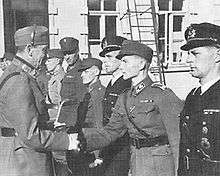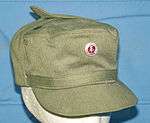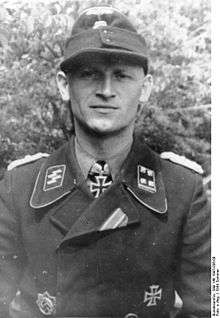M43 field cap
The M43 field cap or Einheitsmütze was a cap used by the German Wehrmacht and SS, during World War II. The design of the field cap was based on the German Gebirgsjäger's ski cap, the only differences being the bill was slightly extended and the top panel of the hat had a smaller circumference, giving it slightly sloped-in sides. This design and its successors that are still in use today are the German counterparts to the American patrol cap or utility cover.
-

An M43 wool field cap with SS insignia, showing folded and unfolded ear flaps.
-

3 Camouflaged M41 field caps in Heer splinter, Italian, and SS blurred edge. Note sweatband on fall side of SS field cap.
-

The original pike-grey service cap, with neck flap, issued to Austro-Hungarian troops during WWI. Unlike the German Bergmütze, this had a leather peak.
-

Chinese soldiers wearing German supplied uniforms during the Sino-Japanese War.
-

WWII German Gebirgsjäger in Norway. Experienced troops were allowed to wear an edelweiss badge made of metal or embroidered cloth.
-

Finnish soldiers wearing field caps based on the German pattern, 1942.
-

1980s East German National People's Army variant of the Bergmütze, with velcro rather than the original button fastening
Variants
There are several variants of the M43 field cap, starting with the Gebirgsjäger's ski cap. This was the first in the family of caps, and was recognized by a high peak, a teardrop shaped top, a short bill, and a small skirt that folds down to protect the ears in cold. All Bergmützen had a small edelweiss or a grouping of Jäger leaves, depending on the unit. The ski cap was generally made of field grey or field blue wool, depending on whether it was used by the Heer, SS, or the Luftwaffe.
Gebirgsjäger's
.jpg)

The precursor to the German Bergmütze was a service cap first issued to Austrian Imperial-Royal Mountain Troops in 1906. During World War I, this cap was made of Hechtgrau (pike grey) wool and had a turn-down brim to cover the wearer's ears in cold weather. German mountain troops, who initially wore a grey peakless forage cap resembling a sailor cap, adopted the Bergmütze in 1915 as a gesture of solidarity with their Austrian allies. Both the German and Austrian Bergmützen bore edelweiss insignia, the mark of an experienced mountain climber, but, unlike the leather peaks of the Austrian caps, the peak of the German cap was covered with slate grey wool.[1]
Gebirgsjäger's ski cap
The sides of the Bergmütze stand almost straight up, due to the wide top sewn onto the cap. The skirt that surrounds the cap is made in the same wool as the cap, and is double layered in the rear three quarters of the skirt, enabling it to be folded down over the ears. The skirt has a small dip in the front quarter with a divide secured by two small buttons in order to get the skirt around the bill. The small section in the front quarter was built shorter to show the insignia, and cover the wearer's chin or mouth, without disturbing breathing by covering the nose.[2]
Summer ski cap
A summer version of the cap was issued to all Gebirgs that was almost identical to the standard version with some exceptions. It was made of field grey poplin, and the skirt was sewn in place, creating a "fake fold."
Winter ski cap
A winter version of this cap was produced in either white poplin or white wool, depending on wearer's choice or unit. The white poplin version was deliberately over sized to fit over the standard issue cap. It generally did not have any fold or skirt at all. The white wool version was to be worn in lieu of the standard version, thus it was identical to the regular cap, with the exception of having bare aluminum buttons instead of painted ones.
The M41 camouflaged field cap
Development
In 1940, development began on a field cap to be worn in place of the normal overseas cap worn by the regular infantry. Within a year, a simple alternative was developed. It was very similar to the Bergmütze, but made in different materials and with a slightly different cut. The result was the M41 camouflaged field cap.
There are a few different variants of the M41, depending on the branch of the Wehrmacht that used it.
The Waffen SS variant
The SS had reversible M41s made of the same reversible poplin found in their smocks and Zeltbahns. Many were very simple, with no insignia, no fold, and a small sweatband on the fall side of the cap. The cap had a smaller top panel than the Bergmütze, giving it a contoured look. These were produced with two small eyelets on either side of the cap for ventilation. The visor on the cap was extended from the Bergmütze. Caps were made mainly in oak leaf, blurred edge, plane tree, and palm patterns. Contrary to common belief m43 caps were not made in the pea dot 44 pattern and were rarely made in Leibermuster.
Insignia was to be placed on the SS M41, consisting of a neon green or golden yellow BeVo eagle and skull on the spring and fall sides of the cap, respectively. Although, like many things in the SS, this was easier said than done. Many soldiers had the required insignia, but due to supply problems, many had either normal cap insignia or none at all.
The SS model was produced from almost all the camouflaged patterns, and after the siege of Italy in 1944, they were produced in Italian camouflage. The Italian telo mimentico camouflage model was almost exclusive to the 12th SS Hitler Youth Division.
Some samples of these caps show a fake fold or officer piping or both, and most of these were private purchase.
The Heer variant
The Heer (Army) Pattern M41 was identical to the SS Model, except that it was produced from splinter A pattern and Sumpfmuster camouflage material instead of the SS patterns. Insignia on the caps was rarely used, but some have been shown to use a Heer eagle and cockade on a single piece trapezoid. These did not have any folds or skirts at all.
The Luftwaffe variant
The Luftwaffe used caps identical to the Heer type, but including the Splinter B camouflage pattern. The insignia was also made on a trapezoid (though some officer's versions show 2 separate pieces) but with Luftwaffe insignia.
The M43 standard field cap
See also Wehrmacht uniforms
The M43 Einheitsfeldmütze ("standard field cap") was similar to the M41 camouflaged field cap, but made of wool and the skirt was applied to the cap once again. The M43 had many small changes depending on the branch of the Wehrmacht, but are nearly identical to the untrained eye.
The Feldmütze was the German garrison cap, which the much more popular M43 was intended to (and essentially did) replace.
During the Winter War, the Finns were issued with similar ski caps, and uniforms derived from the pre-1936 German pattern.[3] Unlike the Wehrmacht Bergmütze, the field cap was made of light grey wool, did not taper, and had brass or black rubber buttons rather than white metal. When the Finnish army was supplied with German uniforms later in the war, the Nazi eagle of the field cap was replaced by a circular metal badge representing the blue and white national flag.[4]
The Heer
The Heer model of the M43 was made of field gray wool lined with gray cotton (there were some color variations), with varied insignia styles, including 2 separate insignia pieces mounted one above the other (eagle on top, cockade below), a one-piece trapezoid insignia with the national eagle and cockade within the trapezoid, and a T-shaped insignia (again, with the eagle above the cockade). Army M-43s nearly always have a two-button flap. Officer versions (and enlisted men's caps, if privately purchased) were generally made of better quality wool, and might include a partial or full sweatband. Officer caps included silver cord piping around the upper seam (around the top panel), as well as around the upper edge of the front portion of the side panels. The Afrikakorps' soft cover was the M40 visored (peaked) cap, similar in shape to the M41 field cap. This extremely popular cap was made of olive-drab cotton twill lined with loosely woven red cotton fabric for protection from the sun and effective heat transfer from the head. It had a long visor, one-piece "false fold" (rather than functional earflaps), and two metal ventilation eyelets on each side.
Heer is the German word for "army"—but only the German Army. Heer is related to the Old English (Anglo-Saxon) word here (which meant "army").
The SS

The SS Model was nearly identical to the Heer model—though there were some flap button variations (1-button, 2-button)—except with SS insignia applied. The insignia originally was two separate pieces: an eagle and a Totenkopf (death's head); variations in positioning included caps with the Totenkopf located on the upper front of the cap with the eagle positioned on the left side skirt. Insignia was either embroidered, or machine-woven (BeVo). Near the end of the war, the two-piece insignia was replaced with a one-piece trapezoid insignia. Variations: Some caps show a cloth eagle with a metal Totenkopf, although the use of metal insignia on the SS M43 was never authorized. Nonetheless, in combat areas, regulations were sometimes overlooked. An embroidered cap version of the SS Gebirgsjäger sleeve patch was sewn to the left side skirt of the M43, whereas Heer caps always used a sew-on metal Gebirgsjäger insignia. The tropical version of this cap was similar with the exception of no liner and brown on black insignia instead of bone-gray on black.
The Luftwaffe
The Luftwaffe's model was identical to the SS and the Heer's with the exception of being made in field blue wool. The insignia consisted of a machine-embroidered Luftwaffe eagle and cockade on a single piece trapezoid, though some caps show two separate pieces. The tropical version was similar in look, but with a longer bill, lined in red, and four to six buttons on the back to attach a neck shade, basically a piece of cloth to protect the neck from sunburn.
The Panzerkorps
The Panzerkorp's M43 field cap was identical to the other branch field caps, with the exception of them being made in black wool. Insignia differed according to the branch of service. Lining was generally black or brown twill or satin. Army Panzer M43s used the Army eagle and cockade either embroidered or machine-woven; SS Panzer M43s used two-piece (embroidered) or trapezoid machine-woven insignia; Luftwaffe Panzer M43s (Herman Göring Division tank personnel, for example), wore black-backed Luftwaffe insignia, which could be machine-woven, or machine-embroidered. Silver officer piping on Army caps followed the usual Army pattern. Silver cord piping for SS-officer company and field grade officer caps was replaced by white piping (Himmler's order), and was worn only around the top panel (though some officers opted to ignore regulations and followed the Army pattern (piping along the front flaps and turn ups, as well).
Modern use


Mountain units (Gebirgsjäger) of the Bundeswehr still wear M43-style field caps, and are still referred to as Bergmütze. The caps have the "fake fold" mentioned above, and are issued in medium grey for enlisted personnel and a lighter grey with silver piping around the brim for officers. The Edelweiss is still on the left side of the cap above the ear, and the cockade and crossed-swords insignia are present on the front above the bill. Most modern M43 field caps are of a slightly different cut than the original M43, with a wider top, but still very similar to the Gebirgsjäger Bergmütze of WWII. Many modern German police units also use a variant of the M43. Additionally, all other army units wear a simplified version of the M43 cap, without the fold-down ear flaps, in standard Flecktarn camouflage with a BeVo cockade on the front. This is generally worn in the field instead of the Beret. There is also a version of lighter cloth in the desert variant of Flecktarn for use in tropical climates.
See also
- Imperial Austrian Landwehr
- Nazi uniform
- Uniforms and insignia of the Luftwaffe
- Waffen SS uniform
- Kepi